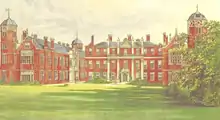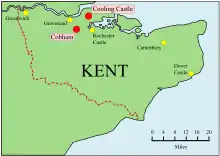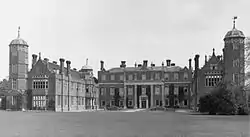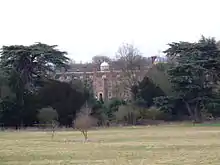Cobham Hall
Cobham Hall is a historic manor house in the county of Kent, England. The grade I listed[1] building is one of the largest and most important houses in Kent,[1] re-built in the Tudor style by William Brooke, 10th Baron Cobham (1527–1597). The central block was rebuilt 1672–82 by Charles Stewart, 3rd Duke of Richmond, 6th Duke of Lennox (1639–1672).



Today the building houses Cobham Hall School, a private boarding school for girls, established there in 1962, which retains 150 acres of the ancient estate.[2]
Building history

There has been a manor house on the site since the 12th century. The current building consists of a pair of Tudor wings built for The 10th Baron Cobham in the 16th century and a later classical central block, the 'Cross Wing', remodelled in 1661–63 by Peter Mills of London for The 3rd Duke of Richmond.[3] The attic storey was extended and other alterations made for The 3rd Earl of Darnley by Sir William Chambers, ca 1767–70[4] A kitchen court was added to the rear in 1771–73. The most notable feature of the interior is the two-storey Gilt Hall, designed and installed by George Shakespear, master carpenter and architect, of London, who made extensive interior alterations, 1770–81.[5] The organ was built by John Snetzler in 1778-9.[6]
The fourth earl, who inherited in 1781, employed James Wyatt extensively, for interiors that included the Picture Gallery and the Dining Room, and for stables and a Gothic dairy.[7] The Library was fitted up by George Stanley Repton in 1817–20,[8] and with his brother, John Adey Repton, in Jacobethan style, including the ceiling for "Queen Elizabeth's Room" (1817).[9] Their father, Humphry Repton, was hired to design a landscape plan for the estate and completed one of his famous 'Red Books' for Cobham in 1790. Cobham Hall remained the family home of the Earls of Darnley until 1957 and is now home to the school. It is open to the public on a limited number of days each year.[10]
The building has been used as a film set. A scene in Agent Cody Banks 2 in which Frankie Muniz fights Keith Allen in a room full of priceless treasures was filmed in the Gilt Hall. Scenes from an adaption of Bleak House were also filmed outside the building, and it was also used in a few scenes in the comedy sketch show Tittybangbang. The Hall is used as the school 'Abbey Mount' in the 2008 film Wild Child starring Emma Roberts and as the Foundling Hospital in the CBBC adaptation of Hetty Feather.
Family owners
Families who have owned the manor include the Cobham family (Barons of Cobham), the Stewart family (Earls of Lennox), and the Bligh family (Earls of Darnley).
References
- Good Stuff. "Cobham Hall (Including Kitchen and Stable Court), Cobham, Kent". britishlistedbuildings.co.uk. Retrieved 23 February 2020.
- "Cobham Hall Heritage Trust". Cobham Hall. Retrieved 23 February 2020.
- Howard Colvin, "Peter Mills and Cobham Hall" in Colvin and John Harris, The Country Seat1970.
- Colvin, A Biographical Dictionary of British Architects, 1600–1840 3rd ed. 1995, s.v. "Chambers, Sir William".
- John Cornforth, in Country Life, 3–10 March 1983, citing documents in Kent Archives Office, noted in Colvin 1995, s.v. "Shakespear, George".
- S. Bicknell, The History of the English Organ, 1999.
- Colvin 1995, s.v. "Wyatt, James".
- John Preston Neale, Views of Seats, vi, 1821, noted in Colvin 1995, s,v. "Repton, George Stanley".
- Colvin 1995, s.v. "Repton, John Adey".
- "Archived copy". Archived from the original on 15 March 2014. Retrieved 15 March 2014.CS1 maint: archived copy as title (link)
Further reading
- Six Wills Relating to Cobham Hall, Archaeologia Cantiana, Vol. 11, 1877, pp. 199–304 (1. William Brooke, 10th Baron Cobham; 2. Frances Countess of Kildare; 3. Frances Duchess of Richmond and Lenox; 4. Charles Stuart Duke of Richmond and Lenox; 5. Sir Joseph Williamson; 6. Lady Catherine O'Brien).
- Waller, J.G., The Lords of Cobham, their Monuments and the Church, Archaeologia Cantiana, Vol. 11, 1877, pp. 49–112 & Vol. 12, pp. 113–166;
- Stephens, P.G., On the Pictures at Cobham Hall, Archaeologia Cantiana, Vol. 11, 1877, pp. 160–188.
- Cobham and its Manors
- Glover, Robert (Somerset Herald), Memorials of the Family of Cobham, Collectanea Topographica et Genealogica, Vol.7, 1841, Chap. XXVII, pp. 320–354
- John Gough Nichols, Sepulchral Memorials of the Cobham Family, 1841: project never completed/published
- F. C. Brooke, Sepulchral Memorials of the Cobham Family (1836–74), completion of Nichols' work.
- Esme Wingfield-Stratford, The Lords of Cobham Hall, London, 1959.